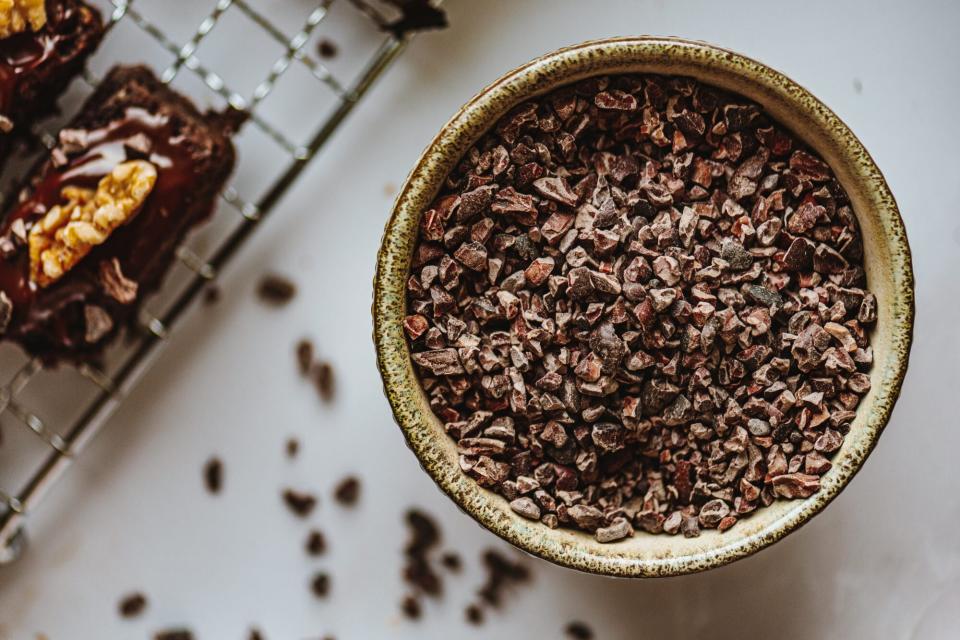What Are Cacao Nibs? Learn About Their Health Benefits and How to Use Them
If you love the bitterness of dark chocolate, it might be time to try cacao nibs. The crunchy bits boast a chocolatey, bitter flavor that's slightly fruity and earthy. The nibs, also known as cocoa nibs, come from the beans (or seeds) of the cacao plant, according to the journal Frontiers in Plant Science. The beans are removed from the fruit, then fermented, dried, and pulverized into pieces. Depending on the manufacturer, the beans might also be roasted before they're crushed.

At first glance, cacao nibs might look like bits of chocolate, but they're actually quite different. The nibs are only made of cracked beans—nothing more, nothing less. On the other hand, chocolate is made of multiple ingredients like cocoa butter (the fatty part of cacao beans), milk, sugar, and vegetable oils. That said, cocoa nibs are essentially a simpler, more wholesome alternative to traditional chocolate. Read on to learn about the health benefits of cacao nibs, plus ways to use them at home.
Related: The Lowdown on Cocoa Powder: Natural Versus Dutch Process
What Are the Nutritional Benefits of Cocoa Nibs?
Though cacao nibs are tiny, they pack a nutritional punch. According to data from the USDA, one tablespoon of cacao nibs contains approximately two grams of fiber. That's about the same amount of fiber in one small banana or three prunes. "Fiber, like the fiber found in cocoa nibs, helps keep our digestion regular and moving along at a normal pace," explains Megan Byrd, R.D., registered dietitian and founder of The Oregon Dietitian. It's also digested slowly by the body, resulting in a gradual increase in blood sugar, she notes. This helps prevent blood sugar spikes, which can lead to energy crashes and type 2 diabetes if they happen too frequently.
Cacao nibs are also rich in antioxidants, according to the journal Frontiers in Immunology. "Antioxidants neutralize free radicals, which are the main cause of oxidative [stress in] cell and tissues," says Byrd. "Oxidative stress [causes] long-term inflammation, and is linked to an increased risk of diabetes, heart disease, and cancer." What's more, the nibs offer potassium, calcium, and magnesium to boot.
How to Use Cacao Nibs
Generally, you can find cacao nibs in the grocery store in the baking secction or next to the dried fruits and nuts. Once you've stocked up on the chocolatey chunks, try adding them to baked goods, smoothies, or your favorite granola. They also work well as a crunchy topper for ice cream or oatmeal. Here are some of our favorite ways to use cacao nibs.
Contrary to popular belief, grains like quinoa or millet aren't just for savory entrées. You can turn the grains into a morning meal like our Quinoa or Millet Breakfast Bowl by simmering them in milk. Top them off with nutty cocoa nibs, maple syrup, and sliced bananas for a hearty and healthy breakfast. Want to use cocoa nibs in an elegant dessert? Serve slices of blood oranges with caramel sauce and cocoa nibs. The soft, juicy texture of the oranges will contrast beautifully with the crunchy nibs. Pair Blood Oranges with Caramel Sauce and Cocoa Nibs with a buttery pound cake or bread pudding, or serve it on its own.
To elevate your morning(or afternoon!) granola, add a satisfying crunch by replacing the dark chocolate in this Granola with Dark Chocolate, Olive-Oil, and Maple with cacao nibs. Or, if you're craving an extra-chocolatey touch, add a bit of both. You can also add cacao nibs to your favorite granola-based recipes, like granola bars or bark.
These Vegan Blueberry Muffins offer antioxidants and fiber, thanks to the blueberries and bananas. But if you'd like to take things up a notch, add a few tablespoons of cocoa nibs to the batter. The sweetness of the fruits will complement the bitter nibs, resulting in a delicious treat.

